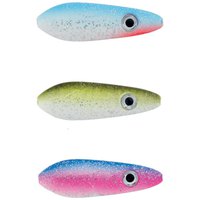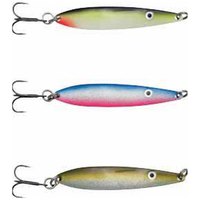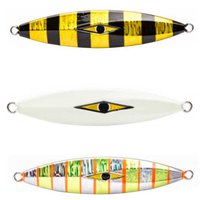Lures Jigs
()Sort by
-

Westin Great Heron jig 13g 55 mm
4.99 €
-

Kinetic Boss jig 16g
2.49 €
-

Kinetic Nakken jig 21g
2.99 €
-

Kinetic Nakken jig 13g
2.99 €
-

Shimano Fishing Ocea Butterfly Wing Slow Jig 160g 112 mm
10.99 €
-

Kinetic Tobias Inline jig 13g
4.99 €
-

Westin D360 jig 10g 55 mm
4.99 €
-

Kinetic Micro Boss jig 3.5g
1.99 €
-

Shimano Fishing Ocea Sardine Waver Slow Jig 160g
10.99 €
-

Kinetic Flax jig 25g
2.99 €
-

Kinetic Pixie Inline jig 10g
3.49 €
-

Kinetic Pixie Inline jig 7g
2.99 €
-

Kinetic Samba Slim jig 20g
2.99 €
-

Kinetic Mon Slim Inline jig 22g
2.99 €
-

Kinetic Pixie Inline jig 13g
3.99 €
-

Kinetic Smolfen Inline jig 17g
3.99 €
-

Westin D360 jig 5.5g 45 mm
3.99 €
-

Kinetic Nakken Inline jig 13g
2.99 €
-

Kinetic Sea Racer Inline jig 25g
3.99 €
-

Kinetic Dragon jig 40g
2.99 €
-

Kinetic Flax jig 15g
2.49 €
-

Kinetic Twister Sister jig 80g
4.49 €
-

Kinetic Silver Arrow jig 16g
2.49 €
-

Kinetic Solo Salar jig 18g
1.99 €
-

Kinetic Mon Inline jig 12g
3.49 €
-

Westin D360 jig 3g 35 mm
3.99 €
-

Kinetic Solo Salar jig 10g
2.49 €
-

Kinetic Stevns jig 27g
2.99 €
-

Kinetic Fax jig 20g
2.49 €
-

Kinetic Rolling Herring jig 300g
7.49 €
-

Kinetic Mon Slim jig 22g
3.99 €
-

Kinetic Octopus Makk Inchiku 120 mm 2 units
2.99 €
-

Kinetic Mon Inline jig 21g
3.49 €
-

Kinetic Cool Herring jig 25g
3.49 €
-

Kinetic Depth Diver jig 150g
4.49 €
-

Kinetic Fax jig 15g
2.49 €
-

Kinetic Silver Arrow jig 24g
2.99 €
-

Kinetic Mon jig 17g
2.99 €
-

Westin F360 jig 16g 75 mm
4.99 €
-

Westin D360° V2 jig 12g 80 mm
5.99 €
-

Westin Great Heron jig 22g 85 mm
5.99 €
-

Westin Great Heron jig 18g 65 mm
5.49 €
-

Westin Great Heron jig 18g 75 mm
5.49 €
-

Kinetic Missile jig 600g
10.99 €
-

Kinetic Tobias Inline jig 18g
4.99 €
-

Kinetic Terminator jig 100g
4.99 €
-

Kinetic Silver Arrow jig 20g
2.49 €
-

Kinetic Smølfen jig 28g
2.99 €
-

Kinetic Als Inline jig 22g
2.99 €
-

Kinetic Nakken Inline jig 21g
2.99 €
-

Kinetic Stevns jig 17g
2.49 €
-

Kinetic Norske Pilken jig 100g
4.99 €
-

Kinetic Fax jig 10g
1.99 €
-

Kinetic Oland jig 25g
2.99 €
-

Westin Moby jig 24g 8.5 mm
6.99 €
-

Westin D360° V2 jig 18g 95 mm
5.49 €
-

Westin Solvpilen jig 24g 110 mm
5.99 €
-

Westin D360 jig 28g 95 mm
4.99 €
-

Yokozuna Caster jig 60g 80 mm
5.99 €
-

Kinetic Solo Salar jig 24g
1.99 €
-

Kinetic Dragon jig 25g
2.49 €
-

Kinetic Missile jig 300g
7.99 €
-

Kinetic Norske Pilken jig 500g
11.99 €
-

Kinetic Smølfen jig 45g
2.99 €
-

Kinetic Crazy Herring jig 60g
2.99 €
-

Kinetic Vik Intermediate jig 18g
2.99 €
-

Kinetic Solo Salar jig 14g
1.99 €
-

Westin Salty Inline jig 8g 6 mm
4.49 €
-

Westin D360 jig 18g 80 mm
4.99 €
-

Westin D360° V2 jig 22g 100 mm
5.49 €
-

Westin Sandy Inline jig 24g 120 mm
6.99 €
-

Westin Salty Inline jig 14g 7.5 mm
4.99 €
-

Westin Moby jig 18g 7.5 mm
6.49 €
-

Westin Salty Inline jig 26g 100 mm
5.99 €
-

Westin Solvpilen jig 20g 100 mm
4.99 €
-

Westin F360 jig 20g 80 mm
4.99 €
-

Mustad Tracershot jig 20g
5.49 €
-

Molix Nano skirted jig 3.5g
5.99 €
-

Yamashiro Keliero jig 40g
4.99 €
-

Shimano Fishing Ocea Butterfly Wing Slow Jig 130g 105 mm
11.49 €
-

Hart Z-Akula jig 150g 190 mm
8.99 €
-

Kinetic Torpedo jig 200g
6.99 €
-

Kinetic Cool Herring jig 40g
3.99 €
-

Kinetic Tobias Inline jig 25g
4.99 €
-

Kinetic Rumba Bucktail 75g
3.99 €
-

Kinetic Mon Inline jig 17g
2.99 €
-

Kinetic Mon Slim jig 16g
3.99 €
-

Westin Sommet jig 28g 120 mm
4.99 €
-

Westin Salty Inline jig 18g 80 mm
5.49 €
-

Mustad Rip Roller jig 250g
15.99 €
-

Mustad Staggebord jig 200g
14.99 €
-

Kinetic Beast jig 200g
5.99 €
-

Kinetic Beast jig 60g
3.49 €
-

Kinetic Boss jig 12g
2.49 €
-

Kinetic Twister Sister jig 400g
12.99 €
-

Kinetic Crazy Herring jig 28g
1.99 €
What is jig fishing?
Jig lures are a popular type of fishing bait used by anglers for various fishing techniques. They consist of a weighted head and a hook, typically covered with a skirt made of silicone or other materials. The design of jig lures allows them to mimic the movement of prey fish, making them effective in attracting predatory fish species. You can buy these lures from these brands: Shimano Fishing, Daiwa, Hart, Mikado, and SPRO.Jig fishing is a fishing technique that involves using a jig, which is a type of fishing lure or bait attached to a jig head, to entice fish to strike. Jig fishing is popular among anglers for its versatility and effectiveness in catching a wide range of fish species in both freshwater and saltwater environments.
Key elements of jig fishing include:
Jig head: The jig head is a weighted component featuring a hook and a lead or metal head shaped like a bullet, round, or other designs. It provides the necessary weight for the lure to sink and maintains its balance during retrieval.
Skirt or soft plastic trailer: A skirt or soft plastic trailer is attached to the jig head to imitate prey, such as baitfish, crawfish, or other aquatic creatures. The skirt or soft plastic trailer adds lifelike movement, color, and texture to attract fish.
Technique: Jig fishing involves using various retrieval techniques to make the jig move attractively in the water. Common techniques include hopping, dragging, bouncing, swimming, or "jigging" the lure up and down. Anglers impart action to the jig by lifting and dropping the rod tip or by reeling it in at varying speeds, mimicking the movement of natural prey.
Depth and cover: Jigs are versatile and can be used at different depths in the water column, making them effective for fishing shallow areas, deep water, and around various types of cover like rocks, brush, weeds, or structure.
Target species: Jig fishing can target a wide range of fish species, including bass, walleye, pike, panfish, trout, snapper, grouper, and more, depending on the fishing location and the specific jig presentation used.
In fishing, various types of lures are used to attract fish. Bucktails, kabura and inchiku, skirted jigs, and slow jigs are different types of lures used in different fishing scenarios and techniques:
Bucktails: Bucktails are a type of fishing lure consisting of a jig head typically made of lead or other metals and featuring a skirt made of deer hair or synthetic materials tied around the head. The skirt can resemble the appearance of baitfish or other prey. Bucktails are versatile lures used for targeting a wide range of species, including bass, pike, muskellunge, walleye, and more. They are effective for both freshwater and saltwater fishing and can be retrieved using various techniques, such as jigging, bouncing along the bottom, or swimming through the water column.
Kabura and Inchiku: Kabura and inchiku are types of Japanese style jigs used in bottom fishing, particularly popular in saltwater fishing. Kabura jigs: These have a lead head and a silicone or rubber skirt resembling a squid or octopus, often brightly colored. The design allows them to flutter and move attractively when dropped to the bottom and retrieved.
Inchiku jigs: Similar to kabura jigs but typically feature a more streamlined shape with a lead weight at the bottom, resembling an elongated baitfish or squid. They are used by dropping them to the bottom and then lifted and dropped in a jigging motion to entice fish.
Skirted jigs: Skirted jigs are lures that consist of a jig head with a skirt made of silicone or other materials. They often mimic baitfish or crawfish and can be effective for bass fishing, among other species. Skirted jigs are versatile and can be rigged with soft plastic trailers or other attachments to enhance their appeal.
Slow jigs: Slow jigs are specialized lures designed for fishing deeper waters or in currents. They are usually shaped like slender, elongated jigs with a flat or angled profile and are designed to fall slowly through the water. The action of slow jigs is often slower and more deliberate compared to other jigs. They are used in vertical jigging techniques, allowing the lure to flutter enticingly as it descends, which can trigger strikes from various predatory fish species.

























